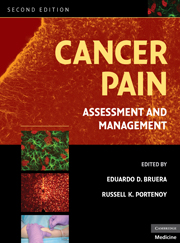Book contents
- Frontmatter
- Contents
- Contributors
- Preface
- SECTION I MECHANISMS AND EPIDEMIOLOGY
- SECTION II EPIDEMIOLOGY AND SYNDROMES
- SECTION III ASSESSMENT
- SECTION IV PHARMACOLOGICAL TREATMENT
- SECTION V OTHER INTERVENTIONAL STRATEGIES
- SECTION VI REHABILITATION AND PSYCHOLOGICAL INTERVENTIONS
- SECTION VII THE ROLE OF ANTINEOPLASTIC THERAPIES IN PAIN CONTROL
- SECTION VIII PAIN IN SPECIAL POPULATIONS
- SECTION IX DIFFICULT PAIN PROBLEMS
- 25 Cancer pain and depression
- 26 Neuropathic pain
- 27 Breakthrough pain
- 28 Bone pain
- SECTION X SYSTEMS OF CARE
- Index
- Plate section
- References
27 - Breakthrough pain
from SECTION IX - DIFFICULT PAIN PROBLEMS
Published online by Cambridge University Press: 06 July 2010
- Frontmatter
- Contents
- Contributors
- Preface
- SECTION I MECHANISMS AND EPIDEMIOLOGY
- SECTION II EPIDEMIOLOGY AND SYNDROMES
- SECTION III ASSESSMENT
- SECTION IV PHARMACOLOGICAL TREATMENT
- SECTION V OTHER INTERVENTIONAL STRATEGIES
- SECTION VI REHABILITATION AND PSYCHOLOGICAL INTERVENTIONS
- SECTION VII THE ROLE OF ANTINEOPLASTIC THERAPIES IN PAIN CONTROL
- SECTION VIII PAIN IN SPECIAL POPULATIONS
- SECTION IX DIFFICULT PAIN PROBLEMS
- 25 Cancer pain and depression
- 26 Neuropathic pain
- 27 Breakthrough pain
- 28 Bone pain
- SECTION X SYSTEMS OF CARE
- Index
- Plate section
- References
Summary
Introduction
Patients with cancer pain often present with fluctuations in pain intensity. Previous surveys have found that this phenomenon, commonly reported as breakthrough pain (BTP), is highly prevalent among patients with cancer pain and predicts more severe pain, pain-related distress, and functional impairment, and relatively poor quality of life. In several surveys, 50%–90% of cancer patients with pain reported that they experienced intermittent flares of their pain, although each survey used different definitions and methodology. BTP has not always been given due consideration in reports on pain in cancer patients, and imprecision in the nomenclature may account for the different meanings of the term. These figures have been confirmed in a large international survey assessing the prevalence of BTP, which showed a prevalence of about 65%, although a referral bias may limit generalizability of the data. BTP may be associated with other conditions of chronic pain. In a noncancer population with chronic pain, 70%–75% of patients with adequate basal pain control experienced severe to excruciating BTP., In a terminal noncancer hospice population, 63% of patients had BTP. Similar to BTP in adults, BTP in children is relatively frequent, although less recognized. In a recent small institutional study with a cross-sectional design, about 60% of children with controlled background pain of different origins had episodes of BTP.
Characteristics
The pioneer study of BTP defined it as a transitory increase in pain intensity from a baseline pain of moderate intensity in patients on regularly administered analgesic treatment.
- Type
- Chapter
- Information
- Cancer PainAssessment and Management, pp. 506 - 514Publisher: Cambridge University PressPrint publication year: 2009



